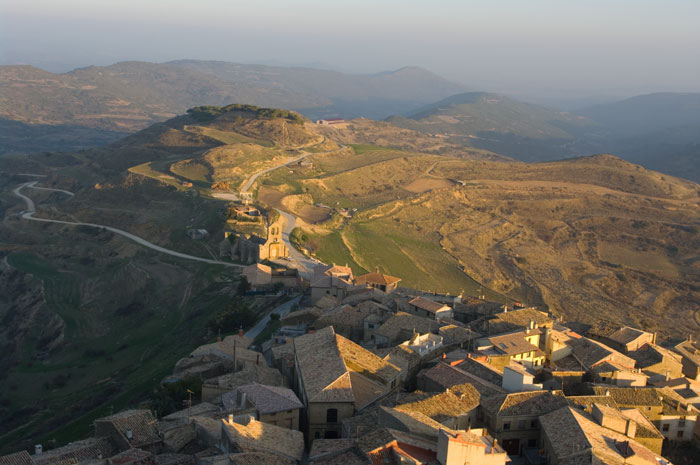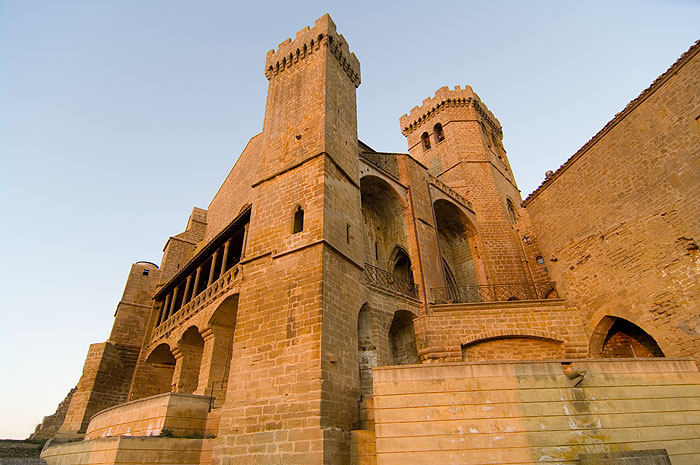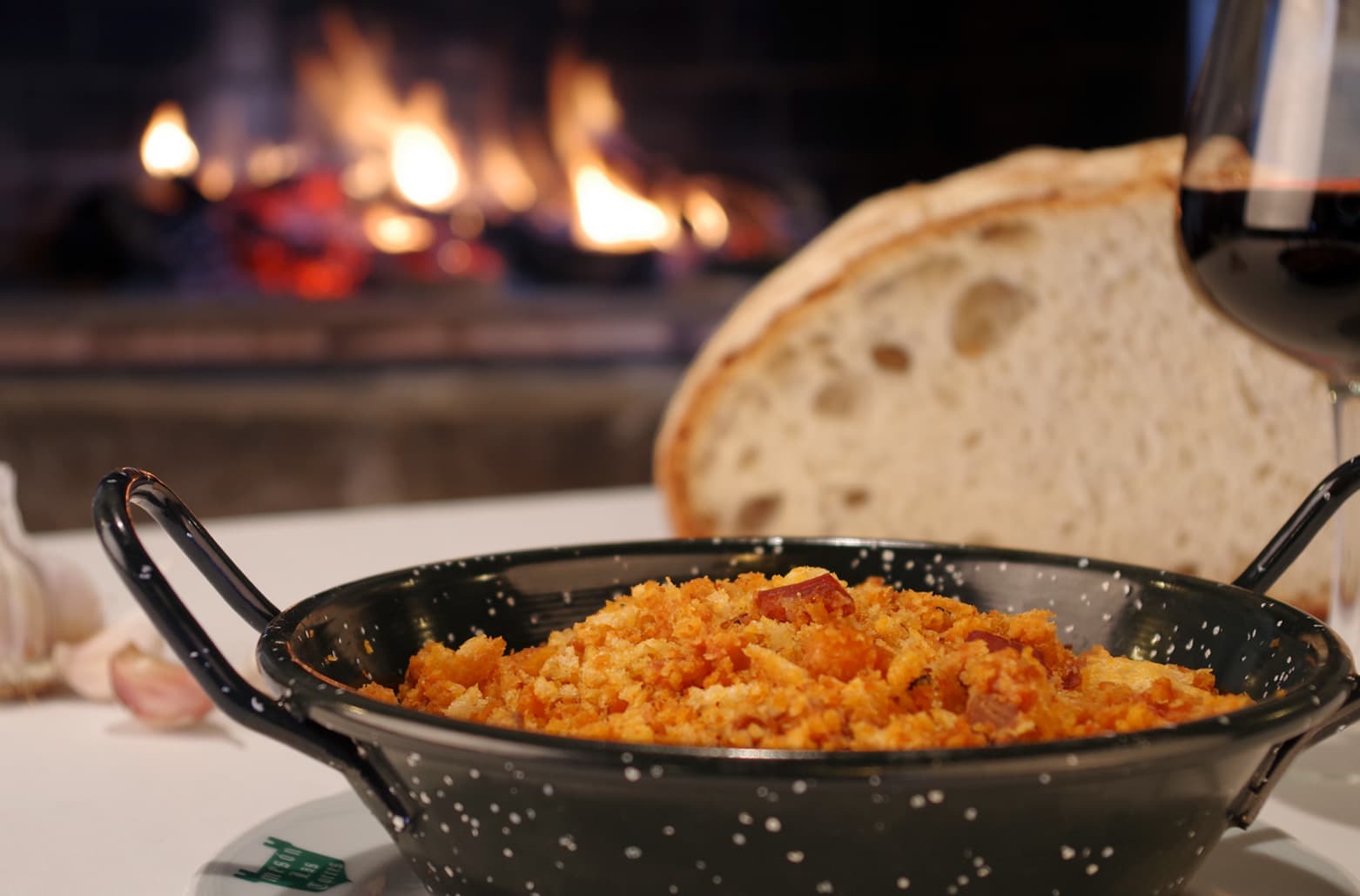Introduction
Nestled in the eastern heart of Navarra, Ujué is more than just a village. It’s a bridge to another era, a living relic of a time when chivalry ruled, and history was written with swords and stone. Located merely 53 km from Pamplona and 20 km from Tafalla, this medieval jewel seems untouched by the relentless march of time.
Perched atop a mountain with a commanding elevation of 815 meters above sea level, Ujué serves as a sentinel, overseeing the vast stretches of Spain’s diverse landscapes. On clear days, one can gaze from the Pyrenean ridges in the north to the lush plains of the Ebro and the imposing silhouette of Moncayo to the south. This panoramic vantage point alone makes a journey to Ujué akin to standing on the shoulders of giants, beholding centuries of tales laid out beneath.
The allure of Ujué, however, is not just its magnificent views but the tales that its very stones whisper. Stepping into this town is akin to leafing through the pages of a living history book. Its medieval and defensive essence remains impressively preserved. As you wander its narrow, cobblestoned alleys, the shadows seem to dance with echoes of yesteryears—perhaps the clang of a knight’s armor or the march of soldiers preparing for another chapter of heroism.
At the town’s zenith, the Iglesia-fortaleza de Santa María stands as a testament to architectural grandeur spanning from the 11th to the 14th centuries. This church-fortress, both a beacon of devotion and a bulwark of defense, anchors the village’s landscape, casting an ever-watchful eye over the terrain.
For the modern traveler, Ujué promises more than scenic beauty; it offers a journey, a step back into an age of valor, faith, and tradition. Come, let Ujué’s stories enthrall you.

The legend and legacy of a timeless spanish enclave
In the heart of Navarra, enveloped by the whispers of history and the embrace of legends, lies the enchanting town of Ujué. For travelers, this ancient enclave offers more than just scenic vistas—it’s a portal to a storied past.
At the core of Ujué’s tapestry is a tale deeply woven into its local tradition. As legend recounts, a shepherd, while tending to his flock, found himself entranced by a dove. This enigmatic bird, with its entrancing flight pattern, would disappear and reappear from a mysterious crevice. Curiosity piqued, the shepherd clambered up to discover an image of Santa María hidden within. This miraculous discovery soon beckoned nearby villagers. Drawn to the site of this divine revelation, they settled, nurturing the birth of what we now know as Ujué, a haven honoring the Virgin Mary.
However, legends aren’t the sole narrators of Ujué’s inception. Archaeological findings suggest that long before Roman dominance, vascone settlements already marked the terrain surrounding Ujué. As the tendrils of Islam began reaching Navarra’s banks, the scattered inhabitants sought unity. By the late 8th or early 9th century, under Iñigo Arista’s guidance, they rallied around an imposing castle-fortress. Ujué, thus, metamorphosed into both a beacon of defense and an observatory against Muslim advances.
Further validating Ujué’s strategic prowess is a testament from Al-Himyarí. As he narrated, amongst the fortified bastions safeguarding the Kingdom of Pamplona, there stood a fortress of unmatched solidity named Santa María. Perched at an unparalleled altitude, it wasn’t just a fortress; it was a testament to Ujué’s indomitable spirit.
Today, Ujué stands as a testament to both divine interventions and human resilience—a must-visit for those seeking tales etched in stone and soul.
History and faith
Nestled amidst the picturesque landscapes of Navarra, Ujué offers a rich tapestry of history that’s as intriguing as the medieval streets that run through it. A blend of myth, faith, and political upheaval, this town has seen eras come and go but continues to stand tall, preserving its enigmatic past.
The annals of time take us back to the 9th and 10th centuries when Ujué was known as Santa María, a pivotal mountainous border fortress. By the 11th century, the name evolved to Ussue and, eventually, to “Santa María de Uxua” in the 12th.
Historical records pinpoint Ujué’s rise as a town around 1076. King Sancho Ramírez, the first ruler of both Navarra and Aragón, left an indelible mark here. Under his patronage, the Church of Santa María was founded, as documented in a donation charter from 1089. He expanded the castle’s precincts and endowed the town with privileges, decreeing it a free royal villa, its residents free from serfdom.
Despite its decline post the conquests by Alfonso the Battler, Ujué regained prominence during the reign of the Évreux dynasty. Carlos II, often called “the Bad”, showcased immense devotion to Ujué, commissioning the Gothic church and even gifting his heart to the Virgin here. His son, Carlos III “the Noble”, and granddaughter, Queen Blanca, continued this legacy with frequent pilgrimages from their court in Olite.
Fast-forward to the conquest of Navarra by the Crown of Castilla, Ujué’s population surged. In an intriguing twist, an order by Cardinal Cisneros to dismantle the fortress went unheeded. Thus, the church, its fortified towers, and defensive walls remain as sentinel reminders of Ujué’s indomitable spirit.
By 1533, the town’s populace grew steadily, and by the late 18th century, Ujué flourished with 170 occupied homes. The spiritual heart of Ujué, its sanctuary, witnessed shifts in stewardship from the Augustinian clerics to secular priests by the 13th century. Papal interventions and royal decrees shaped its ecclesiastical history, notably by popes Clement VII and Pius V and kings like Philip II and Philip V.
The town’s prosperity shone bright in the 1818 Navarra Cortes census and continued into the 20th century, boasting 1500 residents by 1929.
Today, while its population stands at 171, Ujué’s legacy remains colossal, a testament to Navarra’s rich tapestry of history and faith.

The majestic Church-Fortress of Santa María
Tucked away in the heart of Spain lies Ujué, a testament to the rich tapestry of Spanish history. Its crowning glory? The Iglesia-Fortaleza de Santa María de Ujué, a church-fortress that stands as an enduring symbol of religious devotion and architectural mastery.
Built upon the remnants of an 11th-century Romanesque church, records have traced the origins of this sacred site back to the 10th century, hinting at an even earlier pre-Romanesque temple. It was Sancho Ramírez, ruling from 1076 to 1094, who commissioned its construction, simultaneously granting the villa its unique privileges.
The monument underwent significant alterations under the directive of Carlos II el Malo. He envisioned a grand Gothic central nave, resulting in the demolition of parts of the original structure. Yet, echoes of the Romanesque era persist. The church’s head in three sections with its triple semi-circular apse and a tower appended to the southern wall remain intact. Under Carlos II’s reign, the fortress-like façade was further amplified. Defensive walkways surrounding the church and battlemented towers were constructed, enhancing its fortress characteristics. The southern façade hosts an open gallery, offering breathtaking views of the Navarra riverside.
Venture around the perimeter, and you are greeted by the three Romanesque apses. The central apse boasts captivating Romanesque arches, while the sides unveil columns adorned with peculiar capitals and windows framed by blind arches.
Perhaps most striking is the church’s Gothic entrance, one of Navarra’s most ornate. Vivid reliefs depict scenes from Jesus’s life, a peculiar Last Supper featuring a rooster, and atop, a star with three smiling Magi, alongside a fourth cleric figure, representing King Carlos II.
Inside the church, a Gothic grille delineates the Romanesque head from the central Gothic nave. The central apse cradles an exquisite image of Santa Maria de Ujué, a brilliant manifestation of 12th-century Romanesque sculpture. In the 14th century, Carlos II decreed it to be sheathed in silver. Poignantly, beside it rests the heart of the Navarrese monarch, fulfilling his last testamentary wishes penned in 1385.
Recognized as a National Monument in 1936, the church today enjoys protection under Spain’s Historical Heritage Law, preserving this emblematic treasure for generations to come.
Visitors, when you set foot in Spain, let Ujué’s Iglesia-Fortaleza de Santa María transport you through time, revealing tales of faith, kings, and artistic genius. Spain beckons, Ujué answers.
Ujué’s culinary delight: savoring the World’s Best ‘Migas de Pastor’
Nestled amidst the scenic landscapes of Navarra, the village of Ujué is a tapestry of history, beauty, and gastronomic brilliance. While its medieval streets and impressive historical narrative often captivate visitors, Ujué also tempts the taste buds with its legendary culinary offerings. At the heart of this is a dish that is humble in its origins but has become a gastronomic sensation – the migas de pastor.
Traditionally a shepherd’s meal, migas has a simple composition. In its most basic form, it’s a dish fashioned from readily available shepherd’s ingredients: lamb fat, stale bread, garlic, water, and salt. Yet, from this simplicity emerges a culinary delight that has garnered international acclaim, especially the version hailing from Ujué.

Many consider Ujué’s migas to be the world’s finest, and this reputation owes much to the masterful craftsmanship of the Ibáñez Valencia family. At their establishment, Mesón las Torres de Ujué, they have been dishing out this culinary masterpiece daily for over four decades. Using simple ingredients such as the unique Ujué “cabezón” bread, lard, lamb fat, garlic, tomatoes, mushrooms, ham, and more, they achieve a miraculous amalgamation of flavors, colors, and aromas.
But what’s the secret behind these unparalleled migas? Some believe it lies in the delicate art of slicing the bread into fine flakes. Others argue it’s in the perfect balance of broth, ensuring the migas remain both fluffy and moist. The wood-fired oven, providing intense and even heat, certainly plays a role. The truth is, it might be a harmonious combination of all these elements. Above all, it’s evident that the migas from Mesón las Torres de Ujué are crafted with love and passion, making them a must-savor dish for every visitor.
Every year, Ujué resonates with the celebration of this iconic dish. On September 24th, a ceremonial tasting draws both locals and tourists, turning the village into a hub of culinary festivity. But migas aren’t the sole attraction. Other local delicacies like rosquillas, candied almonds, regional wines, and garlic broth tantalize the palate. Visitors are further treated to an arts and crafts fair, rural sports exhibitions, and showcases of ancient trades – offering a holistic and immersive experience.
For the discerning diner, Ujué doesn’t disappoint. While Mesón las Torres de Ujué stands as a beacon of traditional migas, places like Asador Uxue present traditional Navarran cuisine with contemporary touches. Dining on their terrace is not just a feast for the palate, but a visual treat. Not to be outdone, Casa Urrutia delights with its rendition of migas and a selection of homemade desserts.
In essence, Ujué’s culinary tapestry offers more than just a meal – it provides an experience. An experience of tradition, craftsmanship, and the genuine warmth of its people. So, the next time you’re wandering through Spain’s picturesque landscapes, let Ujué’s ‘migas de pastor’ be a stop on your culinary journey.
Conclusion
Ujué is more than just a historical gem in the heart of Navarra; it’s a culinary pilgrimage waiting to be embarked upon. Beyond its enchanting streets and profound history lies a rich tapestry of flavors that tell a story of tradition, passion, and community. Ujué’s ‘migas de pastor’, with its deep-rooted history and perfected craftsmanship, epitomizes the village’s essence. A visit here is not merely a journey through time but a sensory exploration that will leave a lasting imprint on both the heart and palate. So, when seeking authentic Spanish experiences, remember Ujué – where history and gastronomy dance in delightful harmony.
For further visuals and in-depth information, visit www.ujue.info and www.mesonlastorres.com





